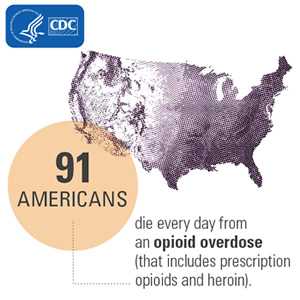Understanding the Epidemic
Drug overdose deaths in the United States continue to increase in 2015

Drug overdose deaths and opioid-involved deaths continue to increase in the United States. The majority of drug overdose deaths (more than six out of ten) involve an opioid.1 Since 1999, the number of overdose deaths involving opioids (including prescription opioids and heroin) quadrupled.2 From 2000 to 2015 more than half a million people died from drug overdoses. 91 Americans die every day from an opioid overdose.
We now know that overdoses from prescription opioids are a driving factor in the 15-year increase in opioid overdose deaths. The amount of prescription opioids sold to pharmacies, hospitals, and doctors’ offices nearly quadrupled from 1999 to 2010,3,4 yet there had not been an overall change in the amount of pain that Americans reported.5,6 Deaths from prescription opioids—drugs like oxycodone, hydrocodone, and methadone—have more than quadrupled since 1999.7
Heroin use is trending up
From 2002–2013, past month heroin use, past year heroin use, and heroin addiction have all increased among 18-25 year olds.8 The number of people who started to use heroin in the past year is also trending up. Among new heroin users, approximately three out of four report abusing prescription opioids prior to using heroin.9 The increased availability, lower price, and increased purity of heroin in the US have been identified as possible contributors to rising rates of heroin use.10,11 According to data from the DEA, the amount of heroin seized each year at the southwest border of the United States was approximately 500 kg during 2000–2008. This amount quadrupled to 2,196 kg in 2013.12
Heroin-related deaths more than tripled between 2010 and 2015, with 12,989 heroin deaths in 2015. The largest increase in overdose deaths from 2014 to 2015 was for those involving synthetic opioids (other than methadone), which rose from 5,544 deaths in 2014 to 9,580 deaths in 2015. One of these synthetic opioids, illegally-made fentanyl, drove the increase.1 It was often mixed with heroin and/or cocaine as a combination product—with or without the user’s knowledge.
What can be done?
We need to improve prescribing of opioids, expand treatment of addiction, and reduce access to illegal opioids.
- Improve opioid prescribing to reduce exposure to opioids, prevent abuse, and stop addiction.
- Expand access to evidence-based substance abuse treatment, such as Medication-Assisted Treatment, for people already struggling with opioid addiction.
- Expand access and use of naloxone—a safe antidote to reverse opioid overdose.
- Promote the use of state prescription drug monitoring programs, which give health care providers information to improve patient safety and prevent abuse.
- Implement and strengthen state strategies that help prevent high-risk prescribing and prevent opioid overdose.
- Improve detection of the trends of illegal opioid use by working with state and local public health agencies, medical examiners and coroners, and law enforcement.
Additional Resources
References
- Rudd RA, Seth P, David F, Scholl L. Increases in Drug and Opioid-Involved Overdose Deaths — United States, 2010–2015. MMWR Morb Mortal Wkly Rep. ePub: 16 December 2016. DOI: http://dx.doi.org/10.15585/mmwr.mm6550e1.
- CDC. Wide-ranging online data for epidemiologic research (WONDER). Atlanta, GA: CDC, National Center for Health Statistics; 2016. Available at http://wonder.cdc.gov.
- US Department of Justice. Automation of Reports and Consolidated Orders System (ARCOS). Springfield, VA: US Department of Justice, Drug Enforcement Administration (DEA); 2011.
- Paulozzi LJ, Jones CM, Mack KA, Rudd RA. Vital Signs: Overdoses of Prescription Opioid Pain Relievers—United States, 1999—2008. MMWR 2011; 60(43):1487-1492.
- Chang H, Daubresse M, Kruszewski S, et al. Prevalence and treatment of pain in emergency departments in the United States, 2000 – 2010. Amer J of Emergency Med 2014; 32(5): 421-31.
- Daubresse M, Chang H, Yu Y, Viswanathan S, et al. Ambulatory diagnosis and treatment of nonmalignant pain in the United States, 2000 – 2010. Medical Care 2013; 51(10): 870-878.
- CDC. Wide-ranging online data for epidemiologic research (WONDER). Atlanta, GA: CDC, National Center for Health Statistics; 2016. Available at http://wonder.cdc.gov
- Centers for Disease Control and Prevention. Demographic and Substance Use Trends Among Heroin Users — United States, 2002–2013. MMWR 2015; 64(26):719-725
- Muhuri PK, Gfroerer JC, Davies C. Associations of nonmedical pain reliever use and initiation of heroin use in the United States. CBHSQ Data Review, 2013.
- Cicero TJ, Ellis MS, Surratt HL, Kurtz SP. The changing face of heroin use in the United States: a retrospective analysis of the past fifty years. JAMA Psychiatry 2014;71:821–6.
- Jones CM. Heroin use and heroin use risk behaviors among nonmedical users of prescription opioid pain relievers — United States, 2002–2004 and 2008–2010. Drug Alcohol Depend 2013;132:95-100.
- US Department of Justice Drug Enforcement Administration. National Drug Threat Assessment Summary. DEA-DCT-DIR-002-15 2014.
- Page last reviewed: August 30, 2017
- Page last updated: August 30, 2017
- Content source:
- Centers for Disease Control and Prevention,
- National Center for Injury Prevention and Control,
- Division of Unintentional Injury Prevention


 ShareCompartir
ShareCompartir
